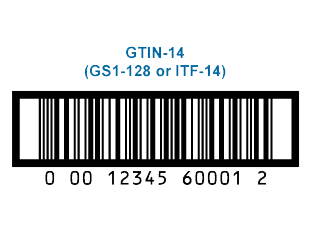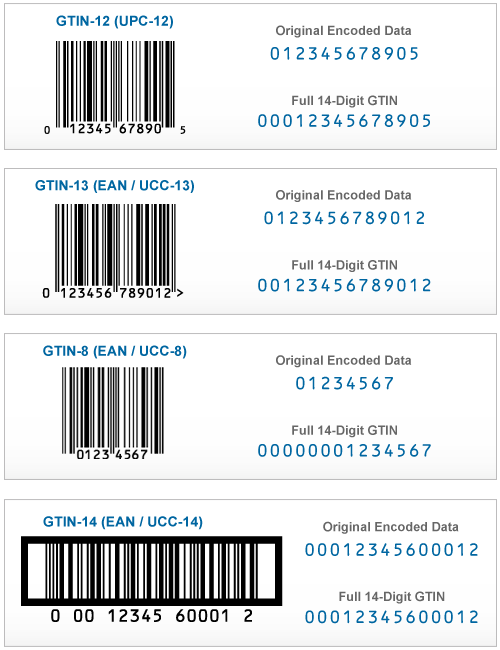GTIN (Global Trade Item Number)
 GTIN describes a family of GS1 (EAN.UCC) global data structures that employ 14 digits and can be encoded into various types of data carriers. Currently, GTIN is used exclusively within bar codes, but it could also be used in other data carriers such as radio frequency identification (RFID). The GTIN is only a term and does not impact any existing standards, nor does it place any additional requirements on scanning hardware. For North American companies, the UPC is an existing form of the GTIN.
GTIN describes a family of GS1 (EAN.UCC) global data structures that employ 14 digits and can be encoded into various types of data carriers. Currently, GTIN is used exclusively within bar codes, but it could also be used in other data carriers such as radio frequency identification (RFID). The GTIN is only a term and does not impact any existing standards, nor does it place any additional requirements on scanning hardware. For North American companies, the UPC is an existing form of the GTIN.
The family of data structures (not symbologies) comprising GTIN include:
- GTIN-12 (UPC-A): this is a 12-digit number used primarily in North America
- GTIN-8 (EAN/UCC-8): this is an 8-digit number used predominately outside of North America
- GTIN-13 (EAN/UCC-13): this is a 13-digit number used predominately outside of North America
- GTIN-14 (EAN/UCC-14 or ITF-14): this is a 14-digit number used to identify trade items at variouspackaging levels
Today, five symbologies support this GTIN data structure: UPC; EAN; ITF-14; UCC/EAN Code 128; and GS1 Databar (formerly Reduced Space Symbology). Of these, ITF-14, GS1-128, and GS1 Databar employ 14-digit data structures of which the 14th character is a packaging level indicator (i.e., item or case). Both UPC and EAN have an implied packaging level of a single item. Therefore, these symbologies support the GTIN data structure without changing the number of encoded data characters. Table 1 further illustrates the relationship between GTIN, legacy terminology, symbologies and use at point of sale. In most cases, the legacy terminology and the symbology are called by the same name. GTIN changes this by separating the name of the data structure from the data carrier or, in this case, the symbology.
GTIN Data Structure |
Legacy Terminology |
Symbology |
Use at POS |
|---|---|---|---|
| GTIN-12 | UPC, UCC-12 | UPC-A, UPC-E | Yes |
| GTIN-13 | EAN, JAN, EAN-13 | EAN-13 | Yes |
| GTIN-8 | EAN-8 | EAN-8 | Yes |
| GTIN-14 | EAN / UCC-14 | GS1 Databar Family | Not Yet |
| GTIN-14 | ITF Symbol, SCC-14, DUN-14, UPC Case Code, UPC Shipping Container Code, UCC Code 128, EAN Code 128 | GS1 Databar Family | Not Yet |
Table 1: Illustrates the relationship between GTIN, legacy terminology, symbologies and use at point-of-sale.
Retailers who wish to accommodate GTIN need to make an important change to current practices because the full 14-digit data string must be processed and stored.
Barcodes and the GTIN
Since the inception of bar codes with the UPC more than 29 years ago, hundreds of thousands of possible number combinations have been issued as manufacturer or company prefixes. GS1 has continually changed the standards of the issuing numbers, but the fact remains that at a point in the very near future they will exhaust the available company prefixes.
The GTIN is a globally unique 14-digit number used to identify trade items, products, or services. GTIN is also an umbrella term that refers to the entire family of UCC.EAN data structures. The entire family of data structures within the GTIN is:
- GTIN-12 (UPC)
- GTIN-13 (EAN-13)
- GTIN-14 (EAN/UCC-128 or ITF-14)
- GTIN-8 (EAN-8)
The full 14-digit GTIN is achieved on a data carrier of shorter length by ‘padding’ the number with left-justified zeros out to 14 digits.See the examples below.
Nothing has really changed in terms of the bar codes that will be used. The UPC is not going away; GTIN is term referring to how the data is stored, i.e., padding the item number with zeroes to a uniform length. Most scanners in use will already scan any bar code within the GTIN family. The storage of the numbers is the issue being addressed.



